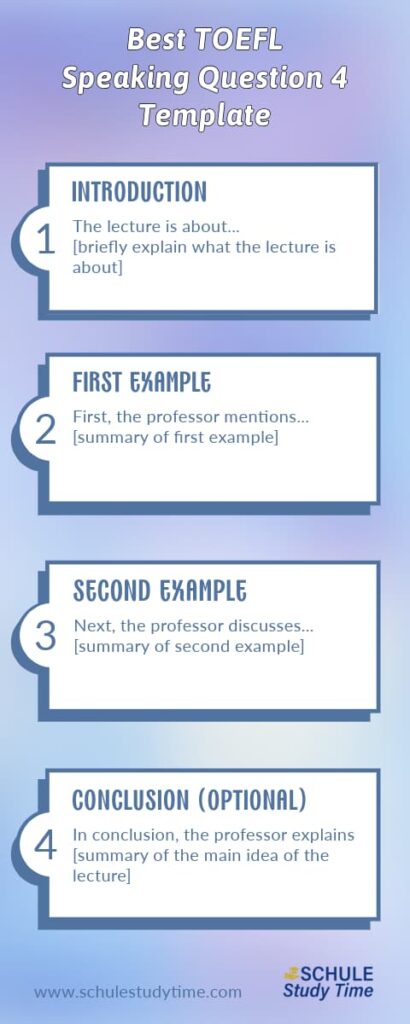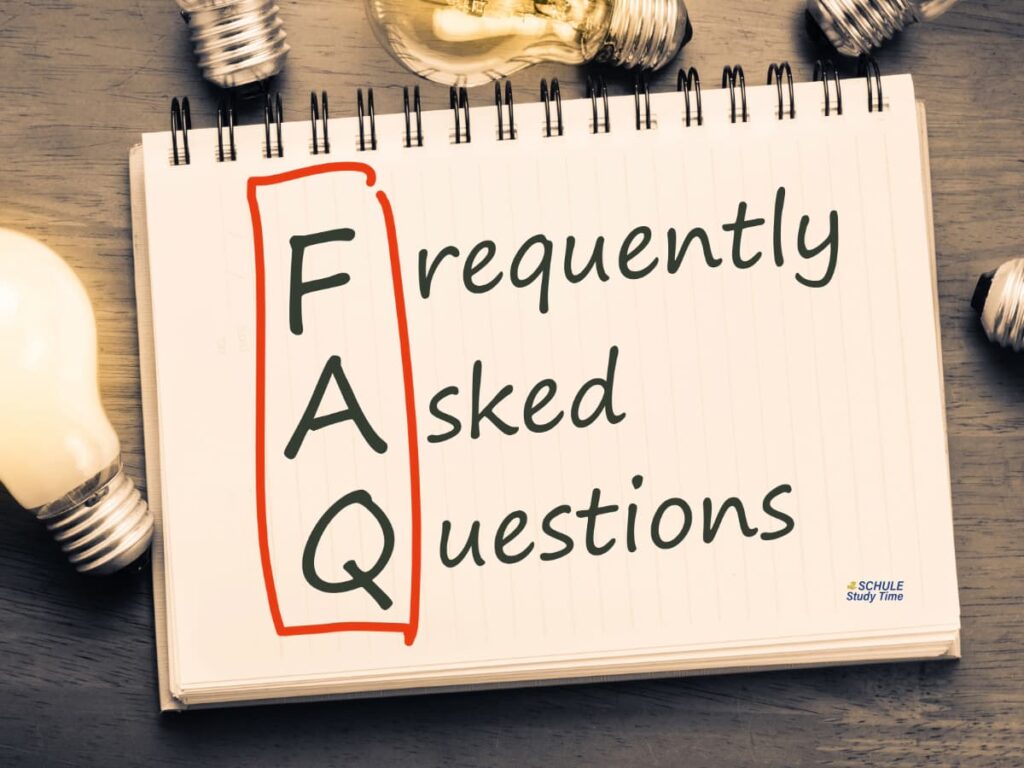TOEFL Speaking Question 4 requires summarising an academic lecture clearly and concisely in just 60 seconds. This 2025 guide outlines the best way to structure your response. It includes a step-by-step TOEFL Speaking Question 4 template, an example question with a sample response, and note-taking techniques to help you organise key points and deliver a clear answer on test day.
Why Read This Guide?
✅ Get a Speaking Template for TOEFL Speaking Question 4
✅ Learn key transition phrases to improve fluency
✅ See high-scoring response examples for better understanding
✅ Avoid common mistakes that lower scores
✅ Find practical study tips to enhance performance
Table of Contents
What Is TOEFL Speaking Question 4?
TOEFL speaking Question 4 is the last question in the speaking section of the TOEFL Test. For TOEFL Speaking Question 4 you’ll listen to a short academic lecture. The lecturer will discuss a topic, and you’ll need to summarise the main points.
👉 1️⃣ In the following section, we’ll break down the first step in approaching TOEFL Speaking Question 4: Understanding Its Format.
Understanding The TOEFL Speaking Question 4 Format
Understanding the format of question 4 is essential for effective time management and clear organisation of ideas. The table below outlines the key components of this question:
| Section | Details |
|---|---|
| Listening (60-90 seconds) | A professor gives a short lecture on an academic concept. |
| Question | The question asks to explain the concept using points and examples from the lecture. |
| Preparation (20 seconds) | Test-takers have 20 seconds of preparation time. |
| Speaking (60 seconds) | Test-takers have 60 seconds to speak. |
👉 2️⃣ With the TOEFL Speaking Question 4 format clear, the next part explains note-taking in detail—take time to study it.
How To Take Notes On The Lecture
Good note-taking is essential as you listen to the lecture. It helps you capture the key ideas you need for your answer.
Follow these steps for taking notes for question 4:
- Write down the topic.
- Identify examples mentioned in the lecture.
- Note key details about each example.
- Use short phrases when taking notes instead of full sentences.
You can see an example of note-taking for question 4 later on in this guide when we look at a TOEFL Speaking Question 4 example question.
👉 3️⃣ Now, we’ll explore the structured approach to answering TOEFL Speaking Question 4 using a speaking template
The TOEFL Speaking Question 4 Template
A TOEFL Speaking template helps you organise key points and deliver a structured answer under time pressure.
Below is a step-by-step TOEFL Speaking Question 4 template to help you structure your response for Question 4 effectively. The template is divided into four parts, each containing a transitional phrase or sentence for use in speaking.
Follow this format to stay focused, avoid hesitation, and deliver a complete answer that meets TOEFL scoring criteria.
Part 1: Introduction
- The lecture is about [briefly explain what the lecture is about]
Part 2: First Example
- First, the professor mentions [summary of first example].
Part 3: Second Example
- Next, the professor discusses [summary of the second example].
Part 4: Conclusion (optional)
- In conclusion, the professor explains [summary of the main idea of the lecture]

👉 4️⃣ Up next, you’ll find an example of a TOEFL Question 4 practice question with a high-scoring answer using the template from this guide. Reviewing it will show you how to structure your responses.
TOEFL Speaking Question 4 Example And Response Using the Template
This section provides a TOEFL Speaking Question 4 practice prompt along with a high-scoring response using the template. Review it to understand how to structure your answer clearly and logically.
Lecture – “Risk Taking In Business”
The professor discusses the importance of risk-taking in business.
Lecture Transcript:
“One of the most important factors in business success is risk-taking. Businesses that embrace calculated risks often experience growth, while those that avoid risks may stagnate or fail. Today, we will discuss two examples that illustrate the role of risk-taking in business.
First, consider the case of a small technology startup that invested heavily in developing an innovative product. Despite uncertainty and financial risks, the company launched a groundbreaking smartphone. Consumers embraced it, leading to massive profits and industry recognition. This example shows that taking a well-calculated risk can result in significant rewards.
On the other hand, let’s look at a long-established retail company that refused to invest in e-commerce. While competitors shifted to online sales, this business stayed with its traditional model. Over time, declining sales and changing consumer behavior led to its bankruptcy. This case demonstrates that avoiding risks can be just as harmful as taking them.
In conclusion, risk-taking is essential in business. When approached wisely, it can drive innovation and success, while avoiding it entirely may lead to failure.”
Question
“The professor discusses the importance of risk-taking in business. Explain the concept of risk-taking using the two examples given in the lecture.”
Example Notes – Risk-Taking in Business Question
When taking notes for TOEFL Speaking Task 4, focus on capturing key ideas and examples concisely. Here’s how you might structure your notes for this question:
Main Concept:
- Risk-taking is key to business success
- Avoiding risks can lead to failure
Example 1: Tech Startup (Successful Risk-Taking)
- Small company invested in new smartphone
- Uncertain outcome, high financial risk
- Phone became a hit → huge profits & industry recognition
- Shows that calculated risks can bring success
Example 2: Retail Company (Failure Due to No Risk-Taking)
- Well-established store refused to adopt e-commerce
- Competitors moved online, but it stuck to traditional sales
- Lost customers → declining sales → bankruptcy
- Shows that avoiding risk can lead to failure
These notes help structure a clear and logical response while ensuring you include key points from the lecture.
🚨 PLEASE NOTE – This note-taking example is for illustrative purposes only. During the test, you will not have the time to write out full words and sentences. It is, therefore, necessary that you come up with a note-taking system for the TOEFL Speaking Test.
High Scoring Sample Response
“The lecture discusses the importance of risk-taking in business and how it influences success or failure. The professor explains this through two examples.
First, the professor mentions an example of a technology startup that took a significant financial risk by investing in an innovative smartphone. Despite uncertainty, the product became a major success, bringing high profits and establishing the company as a leader in the industry. This example demonstrates that calculated risks can lead to substantial rewards.
Next, the professor discusses a well-established retail company that refused to adapt to e-commerce. While competitors embraced online shopping, this company avoided change. As consumer behavior shifted, it lost customers, and eventually, the business failed. This example illustrates that avoiding risk can result in missed opportunities and failure.”
Conclusion (optional) “In conclusion, the professor explains that risk-taking is essential for business growth. While taking risks can lead to great success, avoiding them may cause failure..”
Interested in how TOEFL Speaking responses are graded? Explore the official ETS TOEFL Speaking Rubric.
👉 5️⃣ Now, explore key pitfalls in TOEFL Speaking Task 4 and how to avoid making them.
Common Mistakes And How to Avoid Them
Many test-takers lose points on TOEFL Speaking Question 4 due to common mistakes like poor timing, lack of structure, or missing key details. These issues can make responses unclear or incomplete.
This section highlights frequent errors and provides simple strategies to avoid them, helping you deliver a well-organized and complete answer within the time limit.
- Speaking Too Slowly – Complete the response within 60 seconds.
- Lack of Structure – Follow the TOEFL Speaking Question 4 template.
- Forgetting Key Details – Take good notes during the lecture.
👉 6️⃣ Now, let’s go over some practical study tips to strengthen your preparation for TOEFL Speaking Task 4.
TOEFL Speaking Task 4 Study Tips
Consistent practice is your key to improving your TOEFL Speaking skills. Focusing on timing, clarity, and structure will help you deliver well-structured responses under exam conditions. This section provides essential practice tips to enhance fluency, improve comprehension, and refine your speaking skills. Implementing these strategies will help you feel more confident and prepared for test day.
| Practice Tip | Why It’s Important |
|---|---|
| Practice regularly | Builds confidence and fluency. |
| Use a timer | Helps adjust to the 60-second response time. |
| Listen to academic lectures | Improves comprehension and note-taking skills. |
| Record your responses | Allows you to evaluate clarity and structure. |
| Review and analyse feedback | Helps refine responses and identify areas to improve. |
👉 7️⃣ Up next, you’ll discover free study materials and links to help you get ready for the TOEFL Speaking test.
Links And Resources To Increase Your TOEFL Speaking Score
Check out our other TOEFL prep guides to improve your score:
🔗 TOEFL Speaking Task 1 Guide – Learn a step-by-step strategy for Task 1 responses.
🔗 TOEFL Speaking Task 2 Guide – Summarise campus conversations and explain opinions clearly.
🔗 TOEFL Speaking Task 3 Guide – Connect reading and listening to deliver strong responses.
🔗 TOEFL Test Prep Hub – Explore our blog for expert tips and strategies.
👉 8️⃣ Check the Key Takeaways Summary for key insights, and explore the FAQs for more advice on getting ready for TOEFL Speaking Question 4.
Final Thoughts And Key Takeaways
Keep these key insights in mind when practising Question 4 during your study sessions.
- TOEFL Speaking Question 4 requires listening, note-taking, and structured speaking.
- Using a Speaking template ensures clear and effective responses.
- Taking good notes helps recall key points and examples.
- Practicing regularly improves confidence and fluency.
TOEFL Speaking Question 4 FAQs
Many test takers find TOEFL Speaking Question 4 challenging. Here are some of the most frequently asked questions about TOEFL Speaking Question 4. Review them for useful insights and tips to assist you with this question.

How Can I Prepare For TOEFL Speaking Question 4?
To prepare, practice taking notes while listening to short lectures. Write down the main points and examples. Then, practice summarizing them clearly in 60 seconds. Using a timer can help you get used to the time limit.
What Are Some Good Note-Taking Tips For This Question?
When taking notes, focus on writing down the main points, key details, and examples. Don’t try to write everything. Use short forms or symbols to save time, and make sure your notes are easy to understand when you look at them later.
How Is TOEFL Speaking Question 4 Scored?
Your response is scored on how well you speak, use language, and cover the topic. You need to speak clearly, use good vocabulary and grammar, and make sure your answer is well-organized with a beginning, middle, and end. Your pronunciation and how well your response flows are also important.
What Are Common Mistakes In TOEFL Speaking Question 4?
Common mistakes include adding unnecessary details, not managing time well, and not having a clear structure. Focus on summarizing the main points and examples from the lecture. Practice staying within the 60-second time limit so you don’t run out of time.
Are There Phrases That Can Help Organize My Response?
Yes, using phrases like “The lecture is about…,” “First…,” “Next…,” and “In conclusion…” can help organize your answer. These phrases make it easier for others to understand what you are saying.
What Is The Best Way To Practice For This Task?
The best way to practice is by listening to short lectures or podcasts on different topics, taking notes, and then summarizing what you heard in 60 seconds. Recording yourself can help you check your pronunciation, fluency, and timing. Reviewing these recordings will show you where you can improve.
How Should I Manage My Time During The Response?
Since you only have 60 seconds, it’s important to keep your summary short and focused. Start with an introduction, cover the main points and examples, and finish with a quick conclusion if you have time. Practising with a timer will help you get used to the right speed.
Can I Include A Conclusion In My Response?
Including a conclusion is optional because time is short. If you have a few seconds left after summarizing the main points, you can add a conclusion like, “In conclusion, the professor explains…” But the most important thing is to cover the key points clearly.
✅ We hope you found this 8-Step TOEFL Speaking Task 4 Answer Guide helpful! Take a look at our blog, TEST PREP HUB, for FREE expert articles and resources to help you get ready for the TOEFL Speaking test with confidence.

